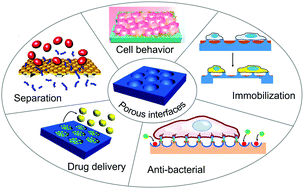Recent advances on porous interfaces for biomedical applications
Abstract
Porous structures on solid surfaces prepared artificially through the water droplet template method have the features of easy operation, low cost and self-removal of templates, and thus are widely applied in the fields of medicine, biomedicine, adsorption, catalysis, and separation, optical and electronic materials. Due to their tunable dimensions, abundant selection of materials, mechanical stability, high porosity, and enlarged pore surface, the formed porous interfaces show specific significance in bio-related systems. In this study, recent achievements related to applications of porous interfaces and a focus into biological and medical-related systems are summarized. The discussion involves the preparation of porous interfaces, and porous interface-induced cell behaviors including culture, growth, proliferation, adhesion, and differentiation of cells. The inhibitory effect of bacteria and separated features of microorganisms supported by porous interfaces, the immobilization of biomolecules related to proteins, DNA and enzymes, and the controllable drug delivery are also discussed. The summary of recent advances pointed out in the study, are suggestive of insights for motivating unique potential applications including their extension to porous interfaces in biomedical materials.



 Please wait while we load your content...
Please wait while we load your content...